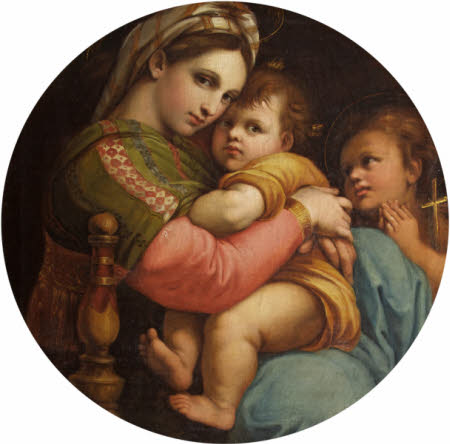Madonna della sedia (after Raphael)
Prince Hoare (Bath 1755 – Brighton 1834)
Category
Art / Oil paintings
Date
1776 - 1779
Materials
Oil on canvas
Measurements
762 x 762 mm (30 x 30 in)
Place of origin
England
Order this imageCollection
Stourhead, Wiltshire
NT 732245
Caption
The Madonna della Sedia by Raphael, a circular painting, or tondo, painted in Rome around 1513/14, is one of the most copied works of the 18th and 19th centuries. The National Trust have at least 15 painted copies, in various media, in their care, alone. The original, once in the Uffizi, seized during the Napoleonic Wars and in Paris between 1799-1815, is now in the Palazzo Pitti, Florence. As legend has it, it was painted on the bottom of a barrel and has gained its title because the Virgin sits in a chair. She is shown as a contemporary Italian woman, wearing a gypsy scarf and green embroidered shawl over her blue dress, tenderly embracing the Christ child, dressed in yellow, and looking directly at us whilst John the Baptist stands behind. It has universal appeal but Ruskin in his Florentine diary of 1845, called it, 'a clever, well-finished, vulgar, piece of maternity, very uncopiable' – abhorring the appearance of the use of real people in devotional religious painting. Prince Hoare’s copy was painted on a trip to Italy either in 1776 or 1779.
Summary
Oil painting on canvas, Madonna della sedia (after Raphael) by Prince Hoare (Bath 1755 – Brighton 1834), 1776 - 1779, after Raphael (Urbino 1483 – Rome 1520). A circular painting with a square frame. Probably painted by the artist on his trip to Italy in November 1776 or July to September 1779 from the original painting in the Uffizi, now in the Pitti Palace, Florence. An exotically dressed Madonna holds the Christ Child whilst both look outwards. Saint John the Baptist is on the right looking to the Madonna and Child.
Provenance
Acquired by Henry Hoare II (1705-85) in 1766 and thence by descent. Given to the National Trust along with the house, its grounds, and the rest of contents by Sir Henry Hugh Arthur Hoare, 6th Bt (1865 – 1947) in 1946.
Credit line
Stourhead, The Hoare Collection (National Trust)
Marks and inscriptions
Verso: Inscribed in chalk on canvas: [ ] 22 Verso: Inscribed in pencil on stretcher: Picture over door leading into Library Lobby
Makers and roles
Prince Hoare (Bath 1755 – Brighton 1834), artist after Raphael (Urbino 1483 – Rome 1520)
References
Stourhead 1785 Schedule of Pictures left by Henry Hoare at his death, 1785

